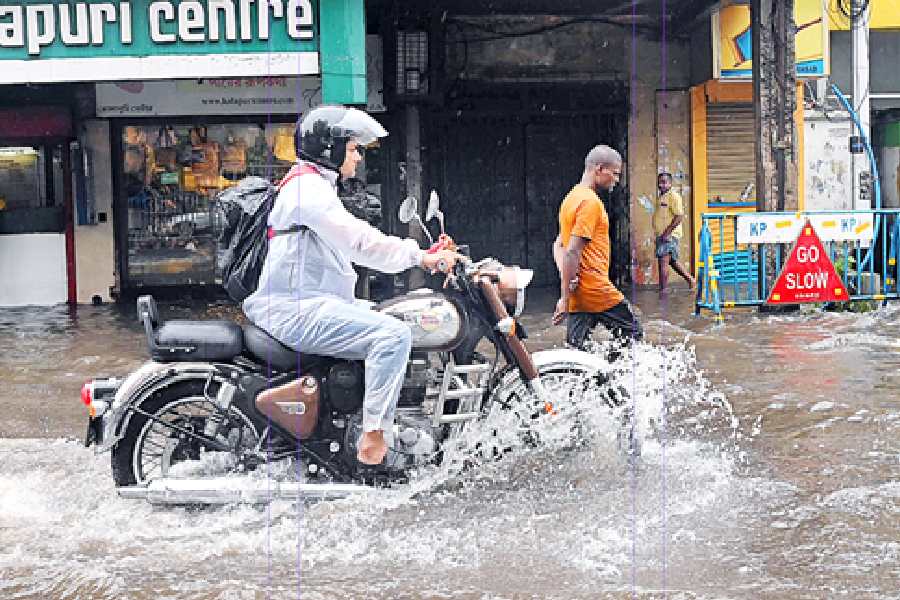Cyclone Dana triggered close to 200mm of rain in Calcutta in a few hours on Friday, after it started making landfall near the Bhitarkanika National Park in Odisha.
Data from over 30 years say the average rainfall Calcutta receives in its rainiest month, July, is around 370mm.
For much of Thursday, notwithstanding a consistently gloomy sky, the city only got intermittent drizzles. Many Calcuttans who went to bed thinking Dana was a damp squib woke up to waterlogged neighbourhoods.
The city was, however, spared the wrath of winds that Bay cyclones are dreaded for.
Dana hit land with wind speeds of up to 120km an hour but those winds were a safe distance from the city.
The intensity of the showers is likely to dip from Saturday, the Met office said. The sky is likely to be cloudy in parts.
The weather will further improve on Sunday, Met officials said.
The Met forecast was for “heavy to very heavy rain” in Calcutta on Thursday. In Met parlance, it means up to 200mm in 24 hours.
As it turned out, widespread rain started at most places after 5am on Friday and picked up intensity as the morning progressed.
Readings at the pumping stations of the Kolkata Municipal Corporation showed that between 4am and 8pm on Friday, Jodhpur Park received 190mm of rain. Ballygunge and Patuli got 152mm and 145mm during the sameperiod. Maniktala got 108mm and Ultadanga 91mm.
Around 4.45pm, the Met office issued a fresh alert for “an intense spell” of rain in several pockets of south Bengal. Calcutta was among them. What was an on-and-off drizzle in the early evening intensified after 6pm.
Slow-moving system
Dana’s landfall, while still a severe cyclonic storm, started a little before Thursday midnight near Habalikhati Nature Camp in Bhitarkanika in Odisha’s Kendrapara district, around 410km southwest of Calcutta.
“The landfall process has commenced. The forward sector of the wall cloud is entering land,” said a Met bulletin issued at 12.15am.
The landfall process continued for the next eight hours, said a Met official.
“The centre of the storm crossed land between 1.30am and 3.30am. By the time the rear sector of the storm entered land, it was 8.30am,” said H.R. Biswas, head of the weather section at the Regional Meteorological Centre in Alipore.
“The landfall process took longer than we had expected. The system moved very slowly from sea to land. A large portion of the clouds that were part of the system hovered over the Bay of Bengal for hours before they entered land. That is one of the reasons why the rain picked up intensity in Calcutta only in the early hours of Friday. The associated clouds arrived late in the city,” he said.
As a cyclone keeps moving over the sea, the uninterrupted supply of moisture ensures the continuous formation of new clouds. Once on land, this process becomes slower because of a halt in the supply of moisture.
Winds missing
Both Amphan (May 2020) and Remal (May 2024) had brought over 200mm of rain to Calcutta, as Dana nearly did. But what was missing in Dana’s case was the intensity of the winds.
Amphan, which hit land as a very severe cyclonic storm and generated a peak wind speed of 185kmph during landfall in the Sunderbans, struck Calcutta with a peak wind speed of 112kmph.
Remal hit land in the Sunderbans in Bangladesh, unleashing winds between 110kmph and 120kmph, with gusts clocking 135kmph. In Calcutta, it generated a maximum wind speed of 91kmph.
At the time of landfall, Dana generated wind speeds of 100 to 110kmph in surrounding areas, with gusts clocking up to 120kmph. But these monstrous winds were confined to the core area of impact, said Met officials. The intensity of the winds did not match the Met forecast even in coastal pockets of Odisha.
Till late on Friday, there was no report of the peak wind speed reaching anywhere close to 100kmph even inthe coastal pockets of Bengal, like East Midnapore, which borders Odisha, and the Sunderbans in South 24-Parganas.
The Met office recorded a gust of 43kmph in Alipore around 7.20am, the highest in the city.
“The size of the system was smaller than expected. That is why the intensity of the winds dropped. The diameter of the system was around 500km. Calcutta is over 400km from where the landfall happened. A radius of 250km leaves another 150km,” said Mrutyunjay Mohapatra, the director-general of meteorology, India MeteorologicalDepartment.

